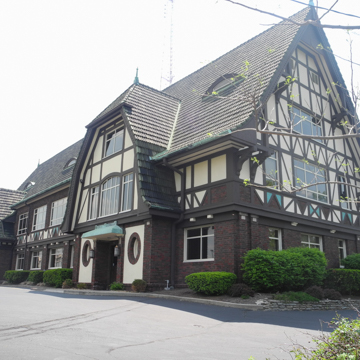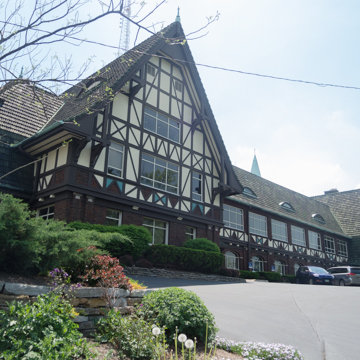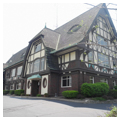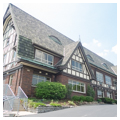The Time Hill factory of the Gruen Watch Company played an important role in early twentieth-century industry in Cincinnati. The Gruen Company was a national leader in watchmaking due to its innovations in watch design and in advertising and merchandizing. Integral to this success was the picturesque, guild-like factory the company built in the hills of Cincinnati. Designed by local architect Guy C. Burroughs of the firm Burroughs and Deeken, the factory is a distinctive half-timbered complex that reflects the influence of the Arts and Crafts movement in America, especially as it relates to the worker and the workplace.
During the nineteenth and early twentieth centuries, Cincinnati was a center of decorative arts and fine craftsmanship. Due in part to the large numbers of German and Swiss immigrants who made Cincinnati their home, the craft-related industries producing watches, clocks, jewelry, and pottery thrived in the city. A 1902 civic promotional piece described the “Queen City” as an “Industrial Center of the United States,” noting that its “industrial development is as varied as the population is cosmopolitan.”
At around the same time the Arts and Crafts movement was reacting to turn-of-the century industrialization, and one of its goals was to improve conditions for workers through production methods and sites of production. The movement called for pleasant and artistic buildings to counter a factory system in which laborers were surrounded by filth and bad ventilation. Many viewed the medieval guild system as an ideal model because it was thought to combine hands-on craftsmanship with a simpler life. In a 1904 issue of The Craftsman, critic Oscar Lovell Triggs wrote that the new industrialism should seek to make labor artistic and educational and the products of labor useful and beautiful. Triggs cited Cincinnati’s Rookwood Pottery as an example of “the purest type of ideal workshop.” Rookwood, which occupied an 1892 half-timbered building in nearby Mount Adams, may have been the best known Cincinnati industry to demonstrate Arts and Crafts influence in the architecture of its work environment, but Gruen Watch Company showed similar impulses in a factory intended to improve the lot of the worker while producing watches that would have strong consumer appeal.
In 1870s, German immigrant Dietrich Gruen founded a watchmaking company in Columbus that became known for its innovation and style, particularly as a pioneering manufacturer of size 16 (railroad standard) pocket watches and wristwatches (for women and men). After the financial panic of 1893, Gruen reorganized the company and in 1898 he relocated to Cincinnati. After his death in 1911, Dietrich’s son, Frederick, became director of the Gruen Watch Company and helped to establish a worldwide reputation through the advertising, merchandizing, and distribution of Gruen watches. Among its notable promotional advances was the display of watches in individual boxes, each with a fixed price printed on a tag and including a guarantee certificate; these were sold directly to retail stores, not through wholesale jewelry houses. The company also launched an advertising campaign in The Saturday Evening Post, the first watchmaker to do so on a national level. The earliest ads referenced the Gruen Guild Watchmaking and featured a quaint village nestled in the mountains as a background scene.
This became reality with the completion of Time Hill, a working embodiment of Arts and Crafts philosophy of combining idealism and commercial enterprise. As Frederick Gruen recalled in his memoir, sometime around 1914 the company decided to leave “the dusty, dirty downtown section” and began to look for a new factory location “up on the hills.”
In conceptualizing the Time Hill development as a guild hall, Gruen was investing not only in its physical plant but also in its advertising image. The landmark building was intended to convey to the public that a Gruen watch was more “than merely a machine,” that it also possessed “that Gruen spirit.” At the same time, the facility also served as an enticement to good workers, and the company claimed that the building attracted “the best employees,” who, in turn, “put dignity, quality, and craftsmanship” into every watch. In this sense, investing in a factory environment that was “comfortable for the workmen” paid off in the quality of the product. The “contented workmen,” Gruen argued, were “the finest tools of the factory.”
Arts and Crafts–inspired design motifs are evident throughout Time Hill, especially in the use of half-timbering and tapestry brick, in the green-tiled gambrel roof, and the use of locally produced Rookwood art tiles. The original landscape, designed by the Cincinnati firm Natorp, included evergreen trees and edelweiss and a rock garden with waterfalls and fountains situated among rustic stairs and pathways down the hill to the street. At the foot of the hill, an antique signboard announced this as the “Home of the Gruen Watchmakers Guild in America.” The factory’s workrooms blended the useful and the beautiful and featured large open spaces and high windows to allow ample light to enter the workshop where the delicate craft of watchmaking took place.
Frederick Gruen died in 1945 and the soon company became a subsidiary of larger watchmaking concern. The building was sold in 1958 and was subsequently used as office space. It is currently occupied by the Union Institute and University, which was already located in the Tudor Revival Procter and Collier/Beau Brummel Building (1921, Elzner and Anderson) directly across McMillan Street.
References
“An Unusual Design for Factory.” Building Age and National Builder44 (February 1922): 37.
Gruen, Fred G. Historical Facts about the Development of the Gruen Watch Makers Guild. Unpublished manuscript, 1940. National Watch and Clock Museum Research Library, Columbia, PA.
Mitra, Dr. Anu M., and Mary Ann Olding, “Gruen Watch Company – Time Hill,” Hamilton County, Ohio. National Register of Historic Places Inventory–Nomination Form, 1995. National Park Service, U.S. Department of the Interior, Washington, D.C.
Painter, Sue Ann. Architecture in Cincinnati, An Illustrated History of Designing and Building an American City. Photographs by Alice Weston, additional text by Beth Sullebarger and Jayne Merkel. Athens: Ohio University Press in association with the Architectural Foundation of Cincinnati, 2006.
Triggs, Oscar Lovell. “The New Industrialism.” The CraftsmanV (1904). In The Craftsman, An Anthology, edited by Barry Sanders. Santa Barbara, CA: Peregrine Smith, Inc., 1978.










